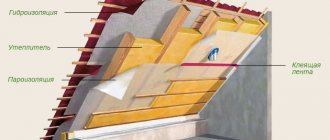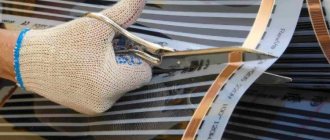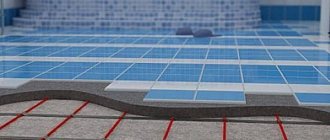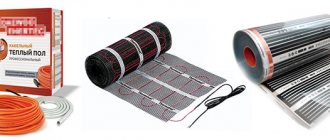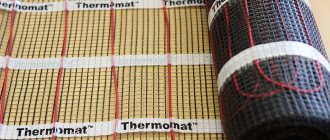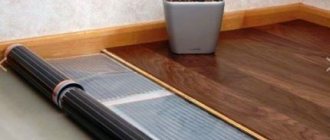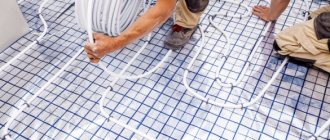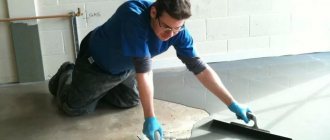The main advantage of ceramic tiles is the possibility of laying them on any of the existing heating systems: water or electric, since they have high thermal conductivity.
If the question is which type of heated floor is best to choose for tiles, then our answer is electric , because it is easy to install and does not put pressure on the ceiling like a water heating system.
Let's take a closer look at all floor heating devices used under tiles to find out which is better in each specific case.
Suitable coverings for heated floors
Very often, owners wonder which heated floor to choose for tiles. For a clear answer, it would be useful to find out the characteristics of all presented products. Choosing a heated floor for tiles is difficult due to the wide range of heating structures of different types and their inherent properties.
Before choosing a specific type of heated floor and floor covering for yourself, you need to establish what can affect the operation of the heating system.
Typically, the types of flooring are as follows:
- organic materials , which include parquet, floorboards, natural linoleum and laminate;
- polymer materials such as PVC tiles and any types of linoleum made from synthetic materials;
- mineral materials - tiles, cement screed, self-leveling floor coverings.
Tile will be the best choice for bathroom flooring
Advertising brochures talk about the existence of laminates with water-repellent properties, as well as hydrophobic coatings for wooden floors. However, you should know that natural materials and moisture are not exactly suitable for each other.
Polymers are less susceptible to the effects of water, but over time, under intense exposure to moisture, coatings made from such materials can deteriorate. For example, linoleum consists of several layers, and if liquid gets between them, the material will swell.
Mineral floor coverings are not at all afraid of water. This means that such surfaces will be the optimal choice for rooms with high humidity. The ideal solution for a bathroom would be to tile it with ceramic tiles.
Price
Here are the approximate prices for underfloor heating elements. By choosing an approximate layout and type of floor, you can make an approximate repair estimate:
- Plastic PEX pipe for water floor – approx. 40 rub. per meter
- Collector groups are sold in sets, the price depends on the length of the comb. Three exits will cost 5,700 rubles, 8 exits - 10 thousand rubles. and more.
- The cabinet itself for the collector is 1200 - 2500 rubles.
- Expanded polystyrene mats with tubercles will cost approximately 430 - 440 rubles. (size 1m x 50 cm or 1 x 1m.)
- Foil polystyrene foam for a water floor 250 rub./m2.
- Damper tape - approximately 25 - 28 rub./m.
- Plasticizer for concrete (10 l.) – 2200 rub.
- Thermostat (depending on complexity) from 2200 to – 8500 rubles.
As for ready-made kits with heating mats or IR film, their cost consists of power, area, equipment and can vary from 2.5 to 14 thousand rubles. and higher.
Types of designs for underfloor heating
Many owners are concerned about the problem of choosing: warm floors under tiles, which is better. Reviews about different types of systems are very contradictory. Therefore, you need to determine the positive and negative characteristics of all products in order to purchase exactly what suits you.
Some experts argue that tile is not the best option for use in residential areas because the material is too cold to walk on barefoot. However, this is only partly true.
Water heated floors are powered by a boiler or boiler
Ceramic tiles are characterized by high thermal conductivity. This property will be an advantage when installing a heating structure under the cladding. In addition, the tile perfectly withstands temperature changes that are created when the contacts are heated during operation of a warm system. It would be useful to clarify the difference between them in order to understand how to choose a warm floor for tiles. Reviews from owners who have already installed one or another system will help you navigate and choose the option that suits you.
Article on the topic: Circulation pumps: purpose, application, main characteristics
Heating elements can be electric or operating on the principle of radiators, using water heated by gas or electricity.
A water heating structure is a closed system in which heated liquid moves through pipes made of copper or polymers. This type of underfloor heating can be connected to a central heating system (in an apartment) or to a boiler or boiler (in a cottage).
A water floor heating system will be the cheapest to operate.
In order to find out how to make a heated floor under tiles in the bathroom, we will consider another type of heating systems.
Of all electrical systems, film heated floors are the most economical
Electrical systems are the most popular method for evenly distributing heat over a surface. It works thanks to a specialized heating component in the form of a wire laid completely over the entire floor. When this specific heating element is heated, the surface is heated. There are several methods for equipping rooms with electric heated floors:
- installation of infrared film ;
- electric cable floor ;
- laying the structure from thermomats .
User opinions
“I chased the cheapness and installed BNK heated floors throughout almost the entire house. Problems appeared within a couple of weeks. The sections “go out” literally one after another, all under a concrete screed - it’s impossible to get close. No one from the manufacturer came to answer the complaint; the warranty service answered without even looking, saying that it was incorrectly installed and that’s all. In short, money was wasted.”
Mikhail, Samara.
“After looking through a lot of forums, websites and reviews, I came to the conclusion that National Comfort heated floors are cheaper than other systems. Moreover, the difference in characteristics is not visible, and the range is frankly richer than that of more expensive brands. I took mats under the tiles in the bathroom and in the hallway, but invited a specialist to install them so that later I wouldn’t have to tear off the tiles if I did something wrong. It works for 3 years – the flight is normal.”
Nikolay, Moscow.
“My review is not so much about the National Comfort heated floors (they fulfill their task), but about the thermostat. I decided that a sophisticated model would be better, and I was wrong. I took the electronic TR-730 because of its information content. It’s just very inconvenient to set modes on three buttons. It was necessary to purchase a simpler device - a mechanic with a rotary handle. And there are no difficulties, and the price is noticeably lower.”
Ivan Markov, Nizhny Novgorod.
“I preferred to buy National Comfort film floor heating - there is less hassle when installing the system. And problems are easier to identify and fix. The purchase was completely worth it. Everything works fine in the bedroom and living room; in the common corridor, by spring, an area of about a square meter near the front door stopped heating up. There we have linoleum, not laminate, and the paths were simply trampled. I will change these areas in the summer.”
Vitaly Serov, Novosibirsk.
“I have TNK heated floors in my kitchen. I did everything with my own hands, because I am an electrician myself. I just didn’t take into account that the tiler’s knowledge would also be useful, so I struggled with the tiles. The heating has been performing well for the second year now, so I don’t share the dissatisfied reviews about the manufacturer National Comfort - you don’t need to rely on chance, if you’re not good at electrical things, and everything will work.”
Igor, St. Petersburg.
Price
| Name of heated floor | Heater type | Installation features | Dimensions | Price, rub |
| NK-250 | Single core cable | Under the screed | 17 m | 2 550 |
| BNK-150 | Two-core cable | 9 m | 2 350 | |
| TNK-155-1 | Single-core cable mat | Under tiles | 1 m2 | 2 770 |
| 2NK-130-1 | Mat with two-core cable | 2 900 | ||
| Green Box 200 | Two-core cable on reel | Universal | 17.5 m | 2 240 |
| PNK-150-1 | Film infrared | Under linoleum, laminate | 1 m2 | 1 670 |
| PNK-220-1 | 1 760 |
Features of a water floor heating system for ceramic cladding
To find out how to properly make a heated floor under tiles, you need to study the principle of its operation and know the nuances for installing the structure.
The peculiarities of the functioning of a water heated floor consist in the circulation of heated water through metal-plastic or brass pipes laid under the finishing floor covering. The system is powered from central or autonomous heating. The cost, installation and energy consumption of this type of floor heating is much cheaper when compared with its electric counterparts.
But there is an unpleasant nuance - in high-rise buildings built in the sixties, the installation of water-heated floors is not possible. Since their floors may not withstand the additional load. In addition, obtaining permission to redevelop the heating system in high-rise buildings is quite difficult.
The installation of such systems has its own nuances. First of all, a compensation polyethylene strip is laid along the walls in order to eliminate gaps and seal the seams. It should be attached to a leveled surface of a concrete screed using dowels or special “parachutes”.
Next, a metallized reflective screen is lined. This is a composite material made of polypropylene fiber and metallized film, which has the properties of reflecting thermal radiation and water vapor barrier. The film must be tightly fixed to the damper tape using tape.
Related article: Shelves on the wall: 60 photos and 8 drawings
During the installation of a water heated floor, all pipes are connected to the distribution manifold
At the next stage, pipes are laid. It is necessary to use special tubes mounted to the mesh. In this case, the distance from the walls should be at least ten centimeters.
In the process of laying pipes, you should pay attention to the fact that they are placed strictly along the guides available on a special grid. Afterwards the adjustment relay and thermometer are installed. At the end of the installation process, the structure is covered with a layer of cement screed.
Characteristics
As already mentioned, IR floors are sold in the form of strips, with a width from 50 to 110 cm, the length is adjustable using notches along which the product can be cut. The heating elements are carbon plates placed inside the film.
The thickness of the film “pie” is also important; unlike other warm systems, it is only 5 mm without a finishing coating. The main difference between film heating and conventional radiator heating is that it is located under a decorative coating
This allows you to establish a comfortable atmosphere in the house. The temperature in it is regulated using a thermostat, the maximum possible heating is 50 degrees, but the recommended temperature level is +21
The main difference between film heating and conventional radiator heating is that it is located under a decorative coating. This allows you to establish a comfortable atmosphere in the house. The temperature in it is regulated using a thermostat, the maximum possible heating is 50 degrees, but the recommended temperature level is +21.
For the floor to function, a power of 220 W is required, and the maximum consumption is 250 W/m2.
Electrical cabling system
In such heating systems, a special two-core wire insulated with reflective material acts as a heat conductor. The cable diameter should not be higher than 8 mm.
Electrical energy passed through a cable, according to the laws of physics, is converted into thermal energy.
The floor heating system is filled with cement screed up to 60 mm thick. Tile tiles are glued on top. The step size when laying the cable is from 80 to 250 mm. The main advantage of the cable design will be ease of installation and high heat transfer. In this case, tiles for a warm floor will become the optimal covering.
A two-core wire is a heat source in a cable-based electrical underfloor heating system
However, there are also some disadvantages. Installation of this system requires covering it with a screed at least four centimeters thick. The total height of the cable, screed and ceramic coating can be about six to eight centimeters, which will significantly reduce the height of the bathroom.
How to get rid of excess moisture in the bathroom?
Unfortunately, heated floors cannot be installed over the entire area of the room. Therefore, droplets of condensation often remain in corners and at points of contact between plumbing fixtures and walls and other surfaces, creating an optimal environment for the development of mold and mildew.
Do you want to prevent fluid from accumulating in these areas? This means it’s worth purchasing a Doctor Sukhov dehumidifier. It is highly efficient, and installation of heating elements is possible on both horizontal and vertical surfaces.
The dehumidifier appears in the form of a cable fixed to the mesh. It can be easily installed under tiles or tiles. The equipment is equipped with a timer. Therefore, you can turn it on immediately after completing the bath procedures, and after heating the coating to 35 °C, the device automatically turns off. Minimum hassle and maximum efficiency.
A favorable environment in the bathroom is the key to the health of all members of your family. That’s why it’s so important to make this room as comfortable as possible! Modern heated floors and dehumidifiers will help with this.
Floor heating system in the form of thermomats
This scheme is usually used when it is necessary to install a warm floor under PVC tiles. This design consists of reinforced polymer-based cells, where a current-carrying cable of small cross-section is reinforced.
This type of heated floor has the undeniable advantage that it does not require screed, but if necessary, it can be poured.
Installation is carried out as follows. Thermal mats with a heating cable are spread on a surface free from furniture and plumbing, then a layer of tile adhesive is applied and the tiles are glued.
Installation of such a floor heating system is very easy and does not require special skills. Thermomats are the same heating cable, only smaller in thickness and attached to a mesh base, so the mats can be laid directly into a layer of tile adhesive, and the mounting coating on which the heating component is fixed will serve as reinforcement.
Related article: Correct alignment of walls for wallpaper: 3 main methods
Even a beginner can install heated floors from thermomats
Heating mats are usually produced up to 3 mm thick, due to which the floor height remains virtually unchanged after installing the heating system.
Undeniable advantages
Among the advantages of heated floors, it is worth highlighting the following facts:
- Reduced humidity levels.
- Uniform heating of the entire thickness of the air, and not just its upper layers.
- No discomfort when leaving the bathroom.
- Safety.
- Full control over the heating level.
The bathroom has a special microclimate, saturated with moisture and heat. These are ideal conditions for mold and mildew to form. But high-quality heated floors effectively dry the air, preventing the development and reproduction of pathogenic microorganisms. Therefore, the benefits of such equipment are undeniable.


